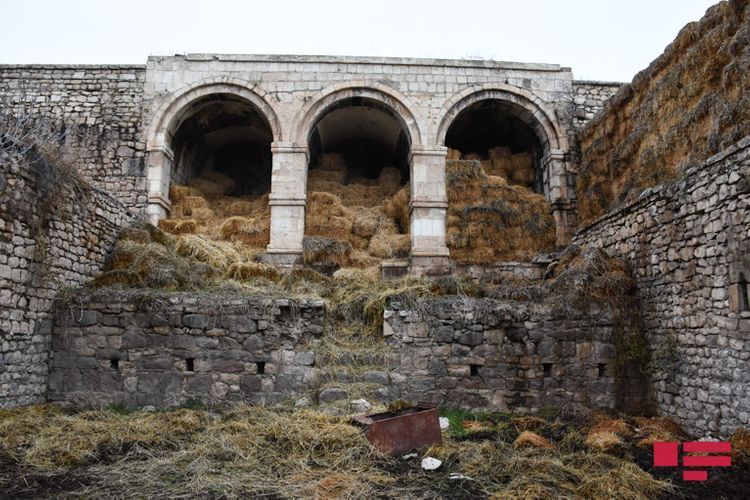You can read previous articles here:
Correspondents of APA have visited the liberated lands from occupation by Azerbaijani Army under the leadership of Supreme Commander-in-Chief Ilham Aliyev. Our employees have prepared a series of reportages in the rubric “In the footsteps of victory”. We present the next reportage from these series:

End of the road to Gochahmadli village
We are going up the muddy road leading to Gochahmadli village. We are driving following in the tracks of a passing car in the mud a few days before us. Ahead of us is our guide's car. It would cause tragedy if we did not follow the road.
 After a long ride, the road splits. One goes to the left - to the foot of the mountain, to the point where ours strengthened, and the other stretches into the village. The car that accompanies us stops here, and so do we.
After a long ride, the road splits. One goes to the left - to the foot of the mountain, to the point where ours strengthened, and the other stretches into the village. The car that accompanies us stops here, and so do we.

We get out of car carefully.
-“Why did stop?” someone from us asked.
-“It is dangerous to go beyond here. The car trail ends here, it does not lead to the village” said our guide

Maşınlarımızı bir az daha irəli sürə bilərik, amma o yol bizi Qoçəhmədli kəndinəmi aparacaq, yoxsa, türklər demiş, Taxtalıköyəmi, müəmmadır. Bələdçimiz də məsləhət görür ki, elə dayandığımız yerdə durub kəndin bir neçə görüntüsünü kameralara alaq.

We look at the village of Gochahmedli from afar: we see no mosque, no monument, no surviving building.

Our first impression is that the Armenians destroyed all the monuments and buildings in Gochahmedli without leaving any. May be I am wrong. But somehow, we were not lucky enough to go to the village itself. We were obliged to return

We leave the main road and this time we go down to the village. This is Gargabazar village of Fizuli. It is located 8 kilometers south of the district. There is information about Gargabazar village in the Ottoman source of 1727.

It is said that there was a "Shah Abbas caravanserai", Giyas ad-Din mosque and a tomb in this village. But we do not know whether they survived after 30 years occupation or were eliminated from the Earth.
“There is a bust,” our photographer Ilkin said at the etrance to the village.
“Where?”

On the right, in the middle of the meadow, there are two tombs with egg-shaped domes (perhaps the remains of an ancient mosque), and at the foot of a hill about a hundred meters away is an ancient building with large arches.

We park our car in the square in the middle of the village and walk so that it would not be safe to drive to the front of the arched building. We have to look at the monuments we see (find!) As fast as possible and finish our shooting before evening.

We are taking steps with the same concern again...
Apart from the monuments we see, there are no survived houses left in Garghabazar, except one or two huts of Armenians used to live and to keep animals.

Inn turned into a barn
Sides of the building have been fenced with iron. It seems we have found what we look for. Is it Shah Abbas or Garghabazar inn?

We enter the inn. Armenians used this cultural monument as a barn, kept animals in its cells. The yard in the middle of the is full of with dung, grass presses have been collected on the second floor.
Despite the date of construction of the inn is mentioned as 1681, the architect is unknown.

The plan and architectural solution of the inn which is 37.70 m long and 23.67 meters wide, is symmetrical to the axis passing through the center and is subordinated to the general construction. It is clearly felt that special attention has been paid on volume-space solution. The inn with a rectangular solution in the plan consists of two large size hall, two small rooms in the right and left sides of the entry for guards, on the main side there are six square rooms for inn owners and merchants.

The doors of the rooms open to a small balcony. The balcony is decorated with two proportionately shapely stone columns and three semicircular arches that complete them from above. Stone stairs placed between the columns create connection between the general yard and balcony. As all the closed rooms of the inn placed in right, left and back sides, there is a roofless large yard in its center, it allowed caravans to spend the night here safely during the warmest months.

The architecture solution of Garghabazar inn reminds of architectual traditions belong to Alban period of Karabakh. In terms of architectural style, Gargabazar inn is similar to the architectural traditions of the Albanian period.
Transformation of the 4-century-old mosque built by Haji Giyasaddin into a warehouse
There is another building above the hill, on the rock. Initially it reminds of Albanian temple. Usually, as in Albanian temples, the stones differ from white stones of the inn, looks like red.

Afterwards we learn that the building we see on the rock is Haji Giyasaddin mosque built in 1683-1684. As it seems from its name, the mosque has been bulit by the villager of Garghabazar named Haji Giyasaddin. Local residents called the mosque as Shah Abbas mosque too.
The mosque is without balcony. It has been completely built with local stone materials, it consists of one hall. The roof is in the form of arched-ceiling. If the entrance door ( there is no sign of that door) is not considered, tree material has not been used here.
As the mosque is full of grass press it is impossible to enter inside. We look at it from the edge. Armenians used this holy place as a warehouse (or may be as stable).
There is another collapsed building in front of the mosque. A big, large stone placed instead of cover. We lift the stone, it is impossible to know wheter it is a well or an underground room used for different purposes.

As the mosque is full of grass press it is impossible to enter inside. We look at it from the edge. Armenians used this holy place as a warehouse (or may be as stable).
There is another collapsed building in front of the mosque. A big, large stone placed instead of cover. We lift the stone, it is impossible to know wheter it is a well or an underground room used for different purposes.

How did the name Gargabazar come about?
The 17th-century inn and mosque indicate that the village of Gargabazar has been located on important caravan routes since ancient times, or why build such a luxurious inn, in modern parlance, a "five-star" hotel in a remote area? The name of the village also gives ground to think so. “Gargha bazari” expression is usually used for very noisy places, "It's like a crow's market," they say.

There is also the expression “ the language of crow” in our language, it is used for the person who speaks in an incomprehensible language

Revolutioner who born in Gargabazar, shot dead and whose body thrown into the Caspian Sea
It's time for us to pull our caravan. But as we come until here, it is not right to leave Garghabazar without looking at the statue that Ilkin pointed out. Of course, it is risky, but what to do it is interesting.

For going to the square where the statue erected, we have to go through the place covered with completely autumn leaves. We are careful to step on autumn leaves we do not what is under them. Luckily, our guide opens a pave for us by checking the autumn leaves.
In the distance we see a helmet left by an Armenian soldier. Our guide said that there was a body of an Armenian soldier, it has been handed over, the helmet belongs to him.
-Was here a battle too?
-What? Each inch of Fuzuli was taken by battle, broter,- Our guide by clearing the autumns with his foot, opens a way- Step on where I step on.
Finally, crossing the Sirat bridge we reach nearby the monument. This is a bust made of concrete on a high column-pedestal. From the position of the monument, it can be assumed that it is a military statue. The place of the plaque on the columnar pedestal is also empty, it is unknown to whom it belongs.
But then we learned that the monument belongs to revolutioner Bolshevik Bunyad Sardarov.
Bunyad Safarov was born in this village in 1889. He actively participated in the establihment of Soviet government in Azerbaijan, he was the cousin of famous revolutionist Khanlar Safaraliyev. Going to Baku in 1903 for work B. Sardarov then joined bolsheviks and started revolutionary activity. On his way back to Baku, the revolutionary's boat, which was sent to Astrakhan on a secret mission in 1919, was seized by the British in the Caspian Sea, those in thhe boat were shot and their bodies thrown to the sea. In the past, the collective farm of the village was named after him. A memorial museum of B.Sardarov has been established in Shah Abbas Caravanserai since 1985.
..... we came
The song of birds is heard somewhere. Frogs are roosting in a nearby lake. It is a wonderful sight. There is nothing left to end such quiet, lonely evenings of Gargabazar, this ancient village, which was always busy
The statue of Fuzuli, then Shah Abbas inn, Haji Giyasaddin mosque and tomb..
It was a fruitful day. Probably, archaeologists are also satisfied after the successful findings.

We return with empty, lonely roads of Fuzuli, where occasionally only cars with special permisson run. We accidentally turned on radio. We would not think that Azerbaijani radio can broadcast in these plains in these mountains; first the sound of advertisments is heard, then the song rises. How beautiful that our radio broadcasting here! For the moment this make us to forget that Karabakh was kept under occupation for 30 years. Never before radio seems so native to me. My heart rejoices. We turn on the sound fully with joy. It is Adalat Shukurov..
We feel good, we dance, sing, we even sing by changing the words of the song: Aghdam, Fuzuli, Jabrayil, Gubadli, Zangilan, kalbajar, Lachin, Shusha... we came.
We!
Your children!
We will not go anywhere anymore!
(to be continued)
You can read more: Memoirs of an officer, the Black Stone Shrine, the destroyed statue of Sabir Ahmadli's brother, an interview with a soldier who became famous for playing the piano as a drum, and the current state of the "Ohanyan Wall" trusted by Armenians.
Photo - Ilkin Nabiyev © APA GROUP



